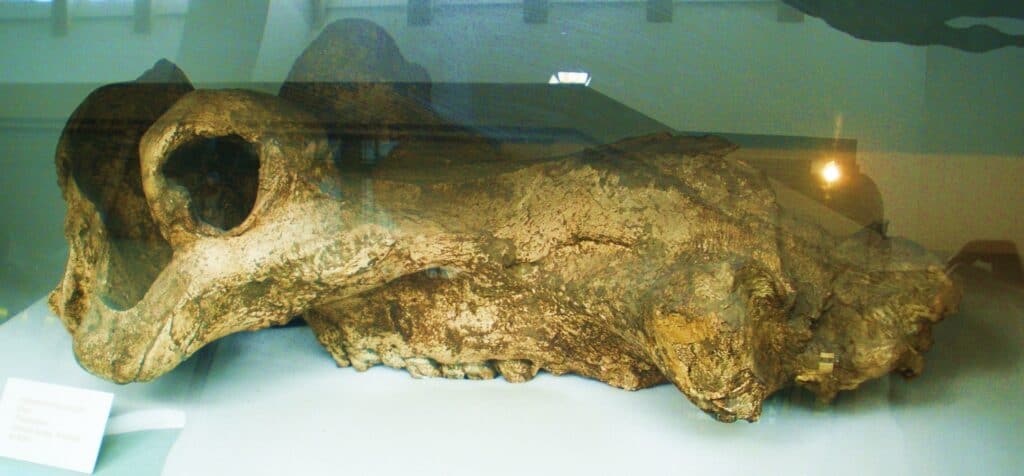The eyes of Hippopotamus gorgops were positioned on eyestalks which allowed it to see above the water surface when submerged.
Advertisement
Hippopotamus gorgops Scientific Classification
- Kingdom
- Animalia
- Phylum
- Chordata
- Class
- Mammalia
- Order
- Artiodactyla
- Family
- Hippopotamidae
- Genus
- Hippopotamus
- Scientific Name
- Hippopotamus gorgops
Read our Complete Guide to Classification of Animals.
Hippopotamus gorgops Conservation Status
Hippopotamus gorgops Facts
- Fun Fact
- The eyes of Hippopotamus gorgops were positioned on eyestalks which allowed it to see above the water surface when submerged.
- Most Distinctive Feature
- Prominent eyes positioned on eyestalks above the head
- Distinctive Feature
- Large canine tusks
- Habitat
- Semi-aquatic habitat in the plains of Africa
- Diet
- Herbivore
- Favorite Food
- Aquatic and marsh plants
- Type
- Hippopotamus
- Special Features
- Prominent staked eyes
- Origin
- Africa
- Number Of Species
- 1
Hippopotamus gorgops Physical Characteristics
- Skin Type
- Smooth
- Weight
- 8,600-9,900 pounds
- Height
- 6 feet
- Length
- 14 feet
- Aggression
- High
View all of the Hippopotamus gorgops images!
Hippopotamus gorgops was an earlier version of the modern-day Hippopotamus and was significantly larger. It has a similar appearance and build but was significantly bigger. Hippopotamus gorgops also outweighed present-day versions considerably. This species of Hippopotamus lived between the Pliocene to the Middle Pleistocene Epoch of the Neogene Period.
Description and Size

German scientist Wilhelm Otto Dietrich published the first description of this species in 1928. Only a few fossils have been found so far, making it difficult to tell the exact habit of this species.
©1,938 × 900 pixels, file size: 462 KB, MIME type: image/jpeg – License
The name Hippopotamus means “river horse,” and it refers to a genus of hoofed mammals with only one living species, the Hippopotamus amphibius. The full name of this extinct species translates as “Gorgon-eyed river horse,” a reference to the strange positioning of the mammal’s eye, which is different from that of the modern Hippopotamus.
The eyes of the H. gorgops were positioned on eyestalk-like orbits which extruded above its head. This would have enabled the creature to see its surroundings clearly even when almost fully submerged underwater. Modern hippos also have eyes placed above their skull, but that of the Hippopotamus gorgops was positioned a lot higher.
Aside from the slight difference in the eye configuration, H. gorgops was also bigger in size compared to their living relatives. It had an estimated length of 14 feet and was up to 6.9 feet tall at the shoulders. This Hippopotamus also weighed between 8,600–9,900 pounds. This means they were about twice as big as modern varieties that weigh between 2,800 and 3,600 pounds.
In terms of their overall appearance, Hippopotamus gorgops weren’t remarkably different from today’s hippos. It had a barrel-shaped torso with wide-open mouths and large canine tusks. Its body was hairless, and it had sturdy, pillar-like legs.
Diet—What Did Hippopotamus gorgops Eat?
Generally, hippos have a herbivorous diet, and their main food source is grasses. However, they have also been observed to exhibit omnivorous behavior. They’re unlikely to hunt prey actively, but they may eat flesh occasionally, given the opportunity. Given the morphology of their bodies, they’re grazers rather than browsers. A recent study that examined the isotope ecology of fossil hippopotamids revealed that the hippos started including a substantial fraction of vegetation in their diets since the late Miocene.
Habitat—When and Where Hippopotamus gorgops Lived
Experts think Hippopotamus gorgops started life out in the plains of Africa during the Late Pliocene Epoch. However, the distribution of the fossils discovered so far suggests that they migrated into Europe later during the early Pleistocene. In fact, the first fossil that was ever discovered was found in Europe.
Hippos have an amphibious lifestyle, and this is reflected in the morphological adaptations of species like the H. gorgops. One of the most notable ones is the placement of their eyes at an elevated position above the head. This is an adaptation seen in animals that live near or close to water bodies and spend significant amounts of time submerged below the water’s surface. The elevated eyes made it possible for the Hippopotamus to see above the water when submerged.
Threats and Predators
Modern hippos are built to kill, and their ancient ancestors would have been equally extremely dangerous. Given their massive size and massive bite force, this voracious aquatic mammal would have easily defended itself against crocodilians and the big cats that would have been abundant in its days.
Modern hippos have a bite force of up to 8,100 Newtons, and that of their ancient relatives would have been significantly higher. They’re also built to run very fast over short distances. All of these, coupled with their sheer bulk, would have protected them against predators. Only juveniles were at significant risk of predators.
In their later days, Hippopotamus gorgops probably had run-ins with humans. There’s a chance that prehistoric humans hunted them, possibly contributing to their extinction. That’s asides from the possible environmental threats they faced during the Paleogene.
Discoveries and Fossils—Where Hippopotamus gorgops was Found
German scientist Wilhelm Otto Dietrich published the first description of this species in 1928. Only a few fossils have been found so far, making it difficult to tell the exact habit of this species. One of the most informative fossils of the Hippopotamus gorgops was discovered during an archaeological excavation at a site in El Kherba, Algeria. The site dates back to the Early Pleistocene epoch and has yielded several Hippopotamus fossils, including a skull that experts think belonged to Hippopotamus gorgops based on the cranial features and general profile. Bones belonging to this species were also found in a nearby locality of Ain Hanisch. Scientists also found bones of this Hippopotamus at Ubeidiya, Israel, dating back to 1.6 million years ago. This suggests that they migrated out of Africa around 1.6 million years ago.
Extinction—When Did Hippopotamus gorgops Die Out?
Hippopotamus gorgops became extinct during the Middle Pleistocene Epoch. This was around the same time as the ice age, which occurred around 1.25–0.7 million years ago. Experts think the species migrated out of Africa long before their extinction (about 1.6 million years ago), along with many other important species.
Similar Animals to the Hippopotamus gorgops
Similar dinosaurs to the Hippopotamus gorgops include:
- Hippopotamus behemoth — This is an extinct species of Hippopotamus that lived during the early Pleistocene in the eastern Mediterranean region of western Asia. The H. behemoth was so similar to the gorgops that some scientists think they might have been the same species existing in different parts of the world.
- Hippopotamus amphibious — This is the only living species of Hippopotamus left in the Hippopotamus genus and one of only two species in the family Hippopotamidae. It is similar in appearance to the H. gorgops but significantly smaller.
- Pygmy hippopotamus — This is a small-sized hippopotamid native to the forests and swamps of West Africa. Although it has the same appearance as the typical Hippopotamus, it is significantly smaller.
Related Animals
View all 104 animals that start with HHippopotamus gorgops FAQs (Frequently Asked Questions)
When was the Hippopotamus gorgops alive?
Hippopotamus gorgops first appeared in Africa during the late Pliocene Epoch. It migrated out of Africa about 1.6 million years ago and became extinct during the Middle Pleistocene. This was before the Pleistocene ice age occurred.
How big was the Hippopotamus gorgops?
Hippopotamus gorgops had an estimated length of about 14ft and stood at about 6.9ft. It also weighed 8,600-9,900 pounds. This means it was larger than its living relative, Hippopotamus amphibius.
What is the largest extinct hippo?
Hippopotamus gorgops hold the title of the largest hippo to have ever lived. It was about twice as big as the average Hippopotamus amphibius, which is the only living member of the Hippopotamus genus.
Thank you for reading! Have some feedback for us? Contact the AZ Animals editorial team.
Sources
- Wikipedia, Available here: https://en.wikipedia.org/wiki/Hippopotamus_gorgops
- ZSL Journal of Zoology / J. M. Harris,T. E. Cerling,M. G. Leakey,B. H. Passey, Available here: https://zslpublications.onlinelibrary.wiley.com/doi/abs/10.1111/j.1469-7998.2008.00444.x
- Prehistoric Fauna, Available here: https://prehistoric-fauna.com/Hippopotamus-gorgops

















